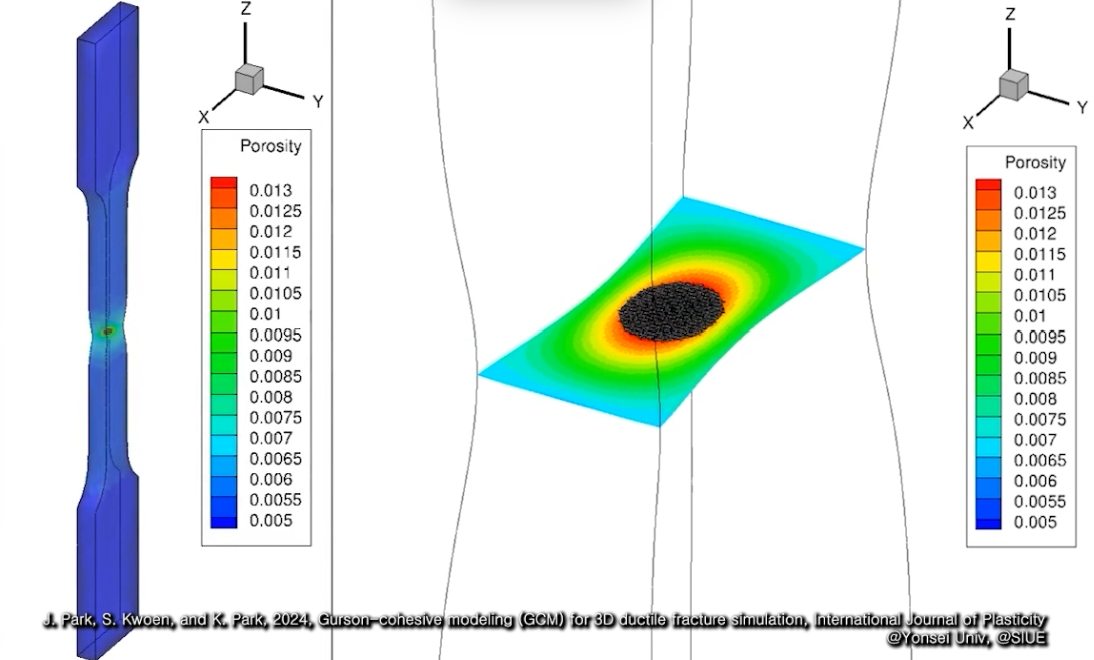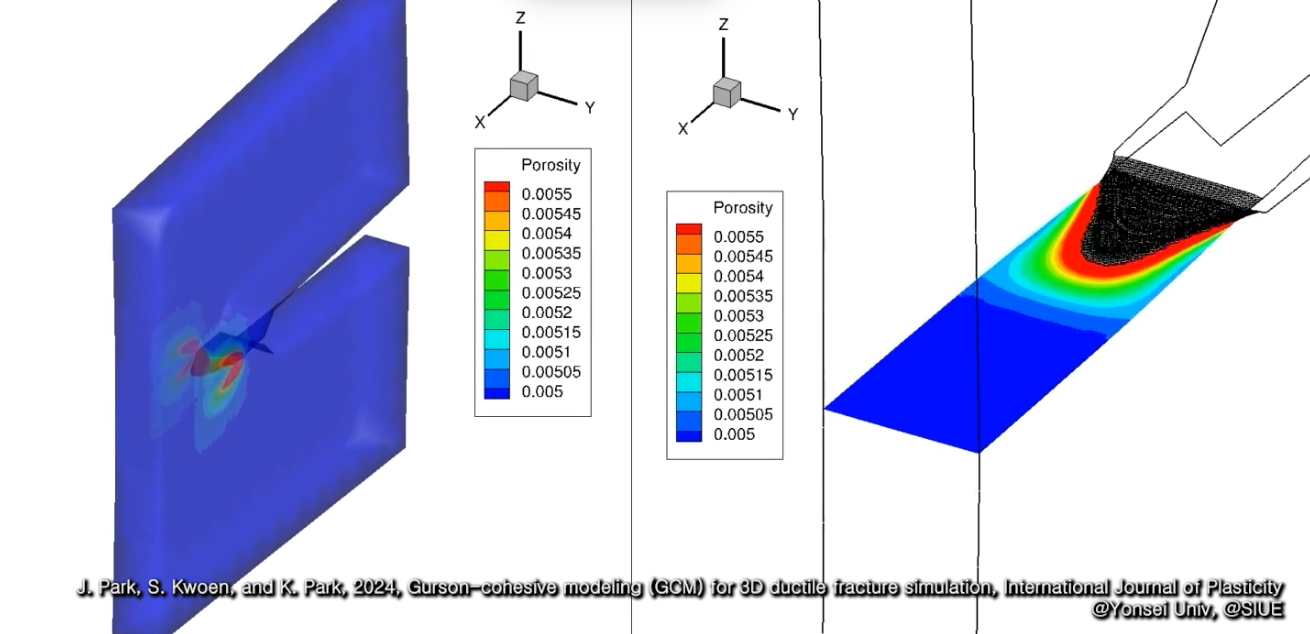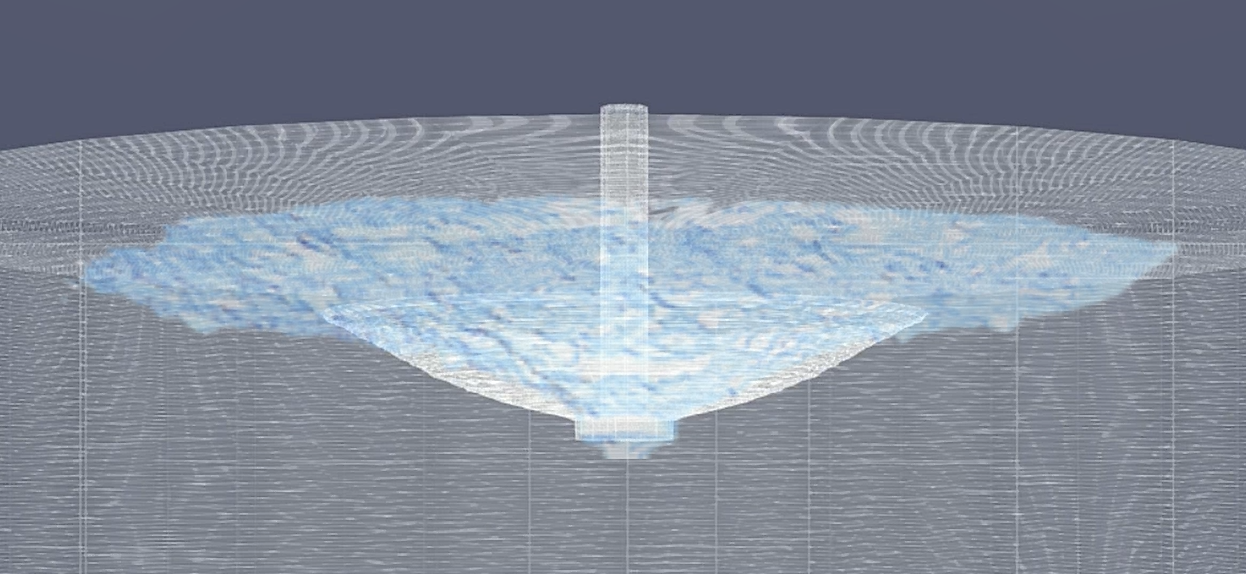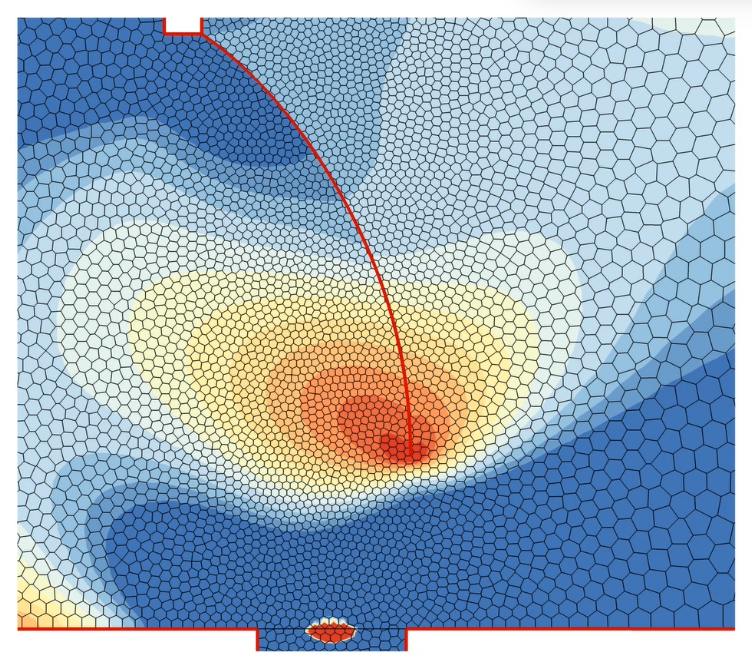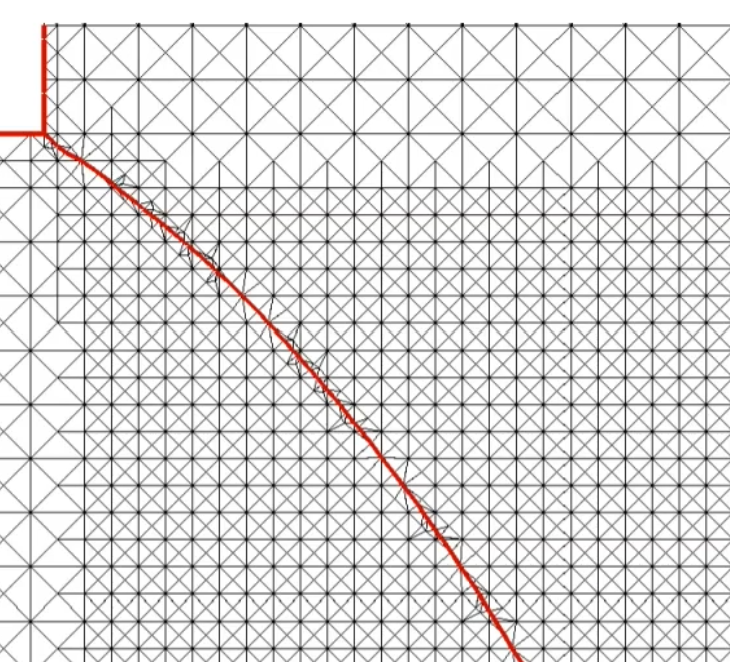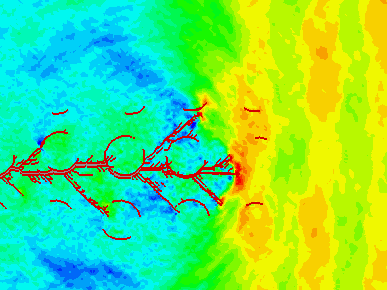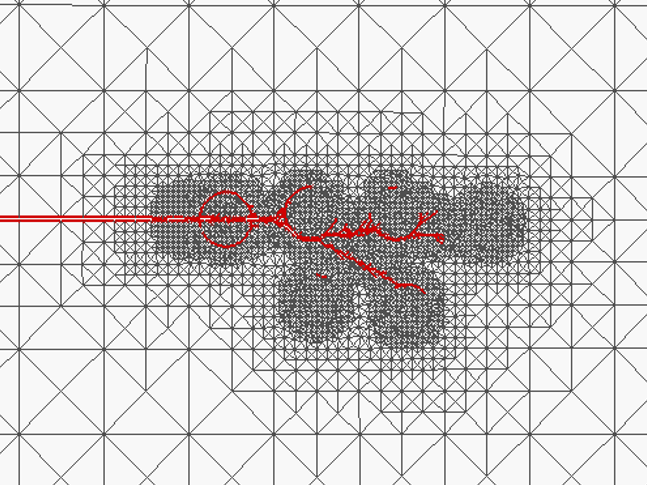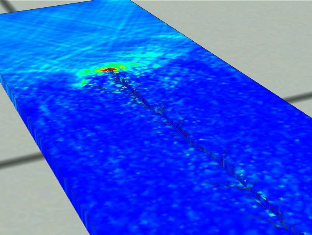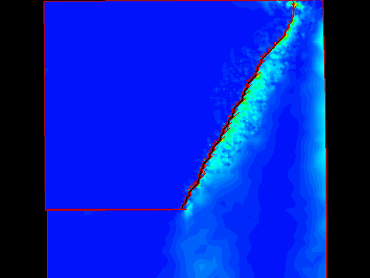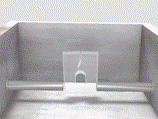Areas of Research
- Computational mechanics for nonlinear problems involving fracture, fragmentation and fatigue
- Fracture behavior of quasi-brittle materials like concrete
- Multi-scale analysis involving different length and time scales
- Structural health-monitoring and retrofitting techniques
Potential-Based Cohesive Zone Model
- Park-Paulino-Roesler (PPR) Model
- Cohesive Frictional-Contact Model
- Mixed-Mode Fatigue Model
- Gurson-Cohesive Model (GCM)

Related Publications
- J. Park, S. Kwoen, and K. Park, 2024, Gurson-cohesive modeling (GCM) for 3D ductile fracture simulation, International Journal of Plasticity 175, 103914
- H. Choi, K. Park, and G.H. Paulino, 2020, Mixed-mode fatigue crack growth using cohesive zone modeling, Engineering Fracture Mechanics, 240, 107234
- H. Baek, and K. Park, 2018, Cohesive frictional-contact model for dynamic fracture simulation under compression, International Journal of Solids and Structures 144-145, 86-99
- K. Park, H. Choi, and G.H. Paulino, 2016, Assessment of cohesive traction-separation relationships in ABAQUS: A comparative study, Mechanics Research Communications 78, 71-78
- K. Park, and G.H. Paulino, 2012, Computational implementation of the PPR potential-based cohesive model in ABAQUS: Educational perspective, Engineering Fracture Mechanics 93, 239-262
- K. Park, G.H. Paulino, and J.R. Roesler, 2009, A unified potential-based cohesive model of mixed-mode fracture, Journal of the Mechanics and Physics of Solids 57 (6), 891-908
- K. Park, 2009, Potential-based Fracture Mechanics Using Cohesive Zone and Virtual Internal Bond Modeling, Ph.D. Thesis, University of Illinois at Urbana-Champaign
Nonlinear Fracture Simulation
- Multiscale Computation
- Cohesive Zone Modelig
- Microbarnching Instability
- Adaptive Mesh Refinement & Coarsening
Related Publications
- H. Choi, and K. Park, 2019, Removing mesh bias in mixed-mode cohesive fracture simulation with stress recovery and domain integral, International Journal for Numerical Methods in Engineering 120, 1047-1070
- K. Ha, H. Baek, and K. Park, 2015, Convergence of fracture process zone size in cohesive zone modeling, Applied Mathematical Modelling 39, 5828-5836
- K. Park, G.H. Paulino, W. Celes, and R. Espinha, 2012, Adaptive mesh refinement and coarsening for cohesive dynamic fracture, International Journal for Numerical Methods in Engineering 92 (1), 1-35
- G.H. Paulino, K. Park, W. Celes, and R. Espinha, 2010, Adaptive dynamic cohesive fracture simulation using edge-swap and nodal perturbation operators, International Journal for Numerical Methods in Engineering 84 (11), 1303-1343
- K. Park, 2009, Potential-based Fracture Mechanics Using Cohesive Zone and Virtual Internal Bond Modeling, Ph.D. Thesis, University of Illinois at Urbana-Champaign
Material Characterization
- Microstructure of Concrete
- Radiation Induced Damage of Concrete
- FRP Debonding
- Concrete Fracture and Size Effect
- Fiber Reinforced Concrete
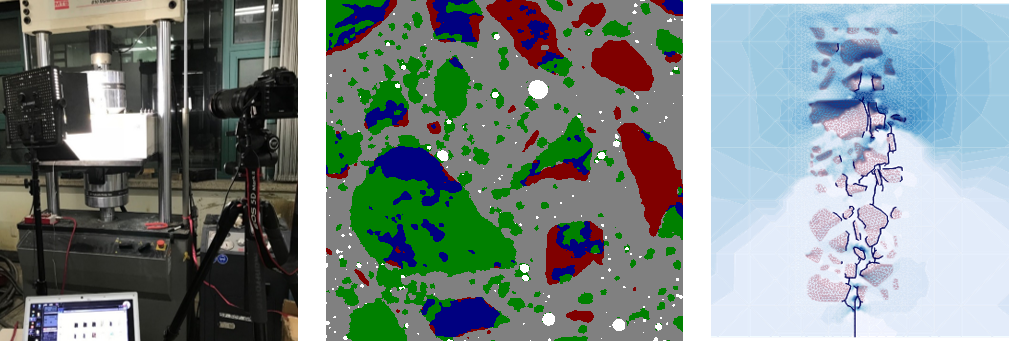
Related Publications
- K. Park, C.W. Chung, C.J. Lee, and T.H. Kwon, 2019, Investigation of neutron radiation effects on properties of cement paste by using small-angle neutron scattering, Cement and Concrete Research 123, 105791
- K. Ha, H. Choi, M. Shin, and K. Park, 2018, On size effect of interfacial fracture between concrete and fiber reinforced polymer, Cement & Concrete Composites 93, 99-106
- K. Park, H.T. Kim, T.H. Kwon, and E. Choi, 2016, Effect of neutron irradiation on response of reinforced concrete members for nuclear power plants, Nuclear Engineering and Design 310, 15-26
- W.H. Kang, T.H. Kwon, H.T. Kim, and K. Park, 2016, Design strength evaluation of RC beams under radiation environments for nuclear power plants, Nuclear Engineering and Design 301, 101-110
- K. Park, K. Ha, H. Choi, and C.J. Lee, 2015, Prediction of interfacial fracture between concrete and fiber reinforced polymer (FRP) by using cohesive zone modeling, Cement & Concrete Composites 63, 122-131
- K. Park, G.H. Paulino, and J.R. Roesler, 2010, Cohesive fracture modeling of functionally graded fiber reinforced concrete composite, Cement and Concrete Research 40 (6), 956-965 (Ranked 21 in Top 25 Hottest Articles in Cement and Concrete Research, April-June, 2010)
- K. Park, G.H. Paulino, and J.R. Roesler, 2008, Determination of the kink point in the bilinear softening model, Engineering Fracture Mechanics 75 (13), 3806-3818
- J.R. Roesler, G.H. Paulino, K. Park, and C. Gaedicke, 2007, Concrete fracture prediction using bi-linear softening, Cement & Concrete Composites 29 (4), 300-312
- J.R. Roesler, Paulino, C. Gaedicke, A. Bordelon, and K. Park, 2007, Fracture behavior of functionally graded concrete materials for rigid pavements, Transportation Research Record 3047, 40-49
Polygonal & Polyhedral Discretizations
- Virtual Element Method
- Non-convex elements
- Morphologic Constructions
- Nearly Incompressible Materials
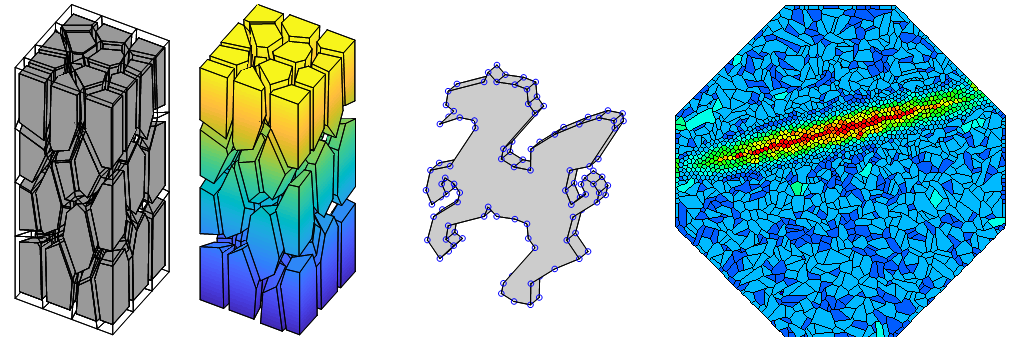
Related Publications
- H. Choi, H. Chi, and K. Park, 2023, Virtual element method for mixed-mode cohesive fracture simulation with element split and domain integral, International Journal of Fracture 240, 51–70
- H.T. Kim, and K. Park, 2022, Computed tomography (CT) image-based analysis of concrete microstructure using virtual element method, Composite Structures 299, 115937
- K. Park, H. Chi, and G.H. Paulino, 2020, Numerical recipes on virtual element method for elasto-dynamic explicit time integration, International Journal for Numerical Methods in Engineering 121, 1-31
- K. Park, H. Chi, and G.H. Paulino, 2019, On nonconvex meshes for elastodynamics using virtual element method with explicit time integration, Computer Methods in Applied Mechanics and Engineering 356, 669-684
Softwares
ABAQUS UEL for the PPR potential-based cohesive model
The PPR potential-based cohesive zone model is implemented in a commercial software, i.e. ABAQUS, as a user-defined element (UEL) subroutine. The source code of the UEL subroutine is provided for a two-dimensional linear cohesive element for educational purposes.
Integration of singular enrichment functions
A mapping method is developed to integrate weak singularities, which result from enrichment functions in the generalized/extended finite element method. The integration scheme is applicable to 2D and 3D problems including arbitrarily shaped triangles and tetrahedra. Implementation of the proposed scheme in existing codes is straightforward. Numerical examples for 2D and 3D problems demonstrate the accuracy and convergence properties of the technique.
